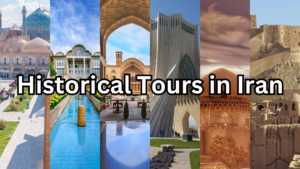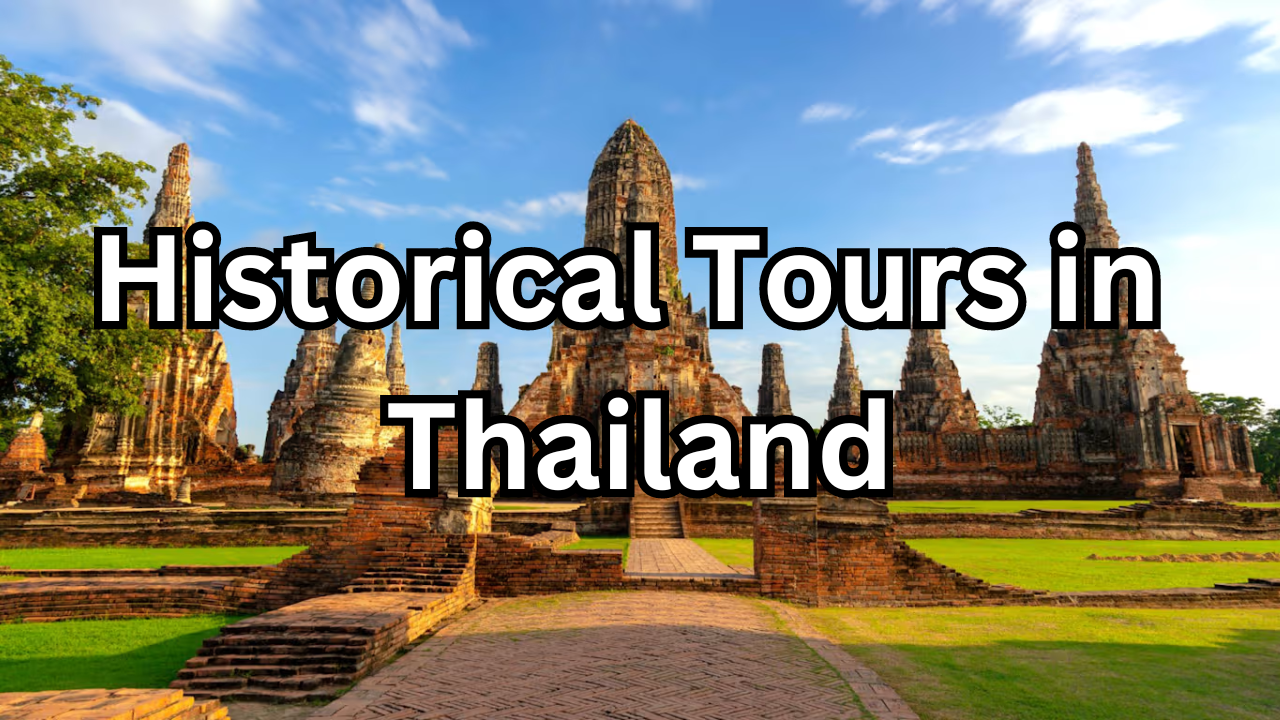
Table of Contents
Introduction:
Thailand’s rich tapestry of history, spanning ancient civilizations, royal kingdoms, and modern transformations, beckons travelers on a journey through time. Historical tours in Thailand offer a captivating blend of architectural wonders, cultural insights, and poignant narratives that illuminate the country’s past glory and enduring heritage. From majestic ruins and sacred temples to poignant war memorials and vibrant museum exhibits, each historical tour unveils layers of Thailand’s captivating history, inviting visitors to explore, learn, and appreciate the legacy of this enchanting land. Join us as we delve into the captivating realm of historical tours in Thailand, where the past comes alive amidst a tapestry of timeless wonders.
Brief overview of Historical Tours in Thailand and cultural heritage:
Thailand’s historical and cultural heritage is as diverse as it is profound, encompassing a timeline that stretches back thousands of years. The country has been home to various indigenous cultures, such as the Mon and Khmer civilizations, whose legacies are still evident in architectural marvels like the ancient temples of Ayutthaya and Sukhothai.
The rise of powerful kingdoms, including the Ayutthaya and Sukhothai Kingdoms, marked significant periods of Thai history, leaving behind a legacy of art, literature, and governance that shaped the nation’s identity. The influence of Buddhism, which arrived in Thailand over two millennia ago, is deeply woven into the cultural fabric, reflected in the ornate temples, religious festivals, and spiritual traditions observed throughout the country.
Thailand’s history also bears the marks of colonial encounters, trade routes, and geopolitical shifts, evident in the fusion of Asian and Western influences seen in art, architecture, and cuisine. The monarchy, with its centuries-old traditions and revered status, continues to play a pivotal role in Thai society, serving as a symbol of continuity and national pride.
Importance of historical tours in understanding Thailand’s past:
Historical tours provide a unique and immersive way to delve into Thailand’s past, offering travelers the opportunity to connect with the country’s heritage on a deeper level. By visiting ancient ruins, museums, and cultural sites, tourists gain firsthand insights into the historical events, artistic achievements, and societal norms that have shaped Thailand’s identity.
These tours offer more than just a glimpse into the past; they provide context, narratives, and perspectives that enhance understanding and appreciation. For instance, exploring the ruins of Ayutthaya or Sukhothai with a knowledgeable guide brings to life the grandeur of these former kingdoms, their architectural prowess, and the stories of rulers and commoners who once thrived there.
Moreover, historical tours foster cultural exchange and dialogue, bridging the gap between past and present, local and global perspectives. They contribute to heritage conservation efforts by raising awareness about the importance of preserving historical sites and traditions for future generations.
In essence, historical tours in Thailand not only showcase the country’s fascinating history but also serve as windows into its cultural richness, fostering mutual respect, learning, and a deeper sense of connection with the past.
Ayutthaya Historical Park
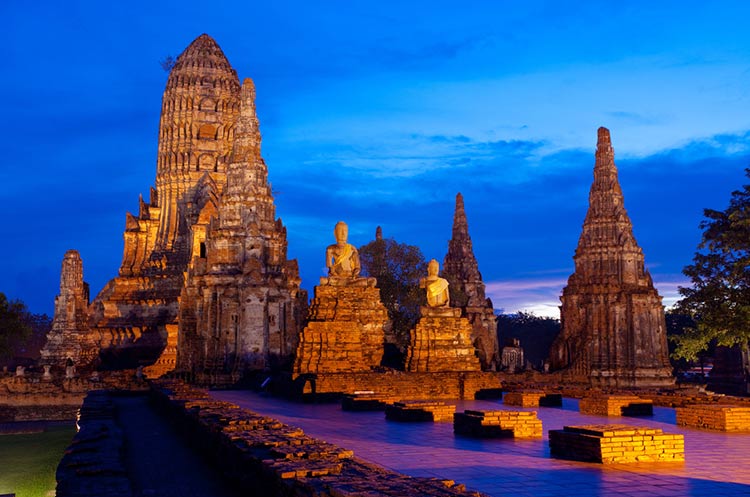
The Ayutthaya Historical Park stands as a testament to Thailand’s glorious past, offering visitors a mesmerizing journey through the remnants of a once-mighty kingdom. Located just north of Bangkok, Ayutthaya served as the capital of the Kingdom of Siam for over four centuries, from the 14th to the 18th century, until its eventual fall to Burmese invaders in 1767.
Today, the Ayutthaya Historical Park is a UNESCO World Heritage site, showcasing a treasure trove of ancient ruins, majestic temples, and intricately carved statues that speak volumes about the grandeur and sophistication of the Ayutthaya civilization. Spread across an expansive area, the park invites exploration and discovery at every turn.
One of the park’s most iconic landmarks is the Wat Mahathat, renowned for the serene Buddha head entwined within the roots of a banyan tree, a poignant symbol of nature reclaiming ancient relics. The towering prang (spires) of Wat Phra Si Sanphet, once part of the royal palace complex, offer panoramic views and insights into the architectural prowess of the era.
Visitors can also marvel at the intricate stucco reliefs at Wat Chaiwatthanaram, depicting scenes from Hindu mythology and daily life during the Ayutthaya period. The nearby Wat Ratchaburana boasts well-preserved murals and underground crypts, providing a glimpse into the religious and funerary practices of the time.
Guided tours of the Ayutthaya Historical Park offer in-depth narratives and historical context, unraveling tales of kings, conquests, cultural exchanges, and the eventual decline of this once-thriving metropolis. The park’s tranquil ambiance, dotted with centuries-old ruins amidst lush greenery and meandering waterways, creates a captivating atmosphere that transports visitors back in time.
Beyond its historical significance, the Ayutthaya Historical Park serves as a reminder of the importance of heritage conservation and the resilience of Thai culture. It is a place where the echoes of the past resonate with the present, inviting contemplation, appreciation, and a renewed sense of wonder at the enduring legacy of Ayutthaya.
Description of Ayutthaya as the former capital of the Kingdom of Siam:
Ayutthaya, situated in the heart of Thailand’s central plains, holds a storied past as the illustrious capital of the Kingdom of Siam. Founded in 1350, Ayutthaya flourished as a major political, economic, and cultural center in Southeast Asia for over four centuries. Its strategic location along river networks facilitated trade and cultural exchange, attracting merchants, diplomats, and artisans from distant lands.
The city’s prosperity was reflected in its grand architecture, bustling markets, and cosmopolitan atmosphere. Ayutthaya’s royal palaces, temples, and monuments showcased the kingdom’s wealth and power, earning it a reputation as one of Asia’s most splendid cities during its heyday.
Highlights of the park’s UNESCO World Heritage sites, including ruins, temples, and statues:
The Ayutthaya Historical Park, designated as a UNESCO World Heritage site in 1991, encompasses a remarkable array of ruins, temples, and statues that bear witness to the city’s former glory. Among its notable highlights are:
- Wat Mahathat: Known for the iconic Buddha head entwined in the roots of a banyan tree, Wat Mahathat was a significant temple in Ayutthaya, housing relics and serving as a center of Buddhist learning.
- Wat Phra Si Sanphet: This temple complex, located within the former royal palace grounds, features impressive chedis (stupas) and prangs (spires) that once housed the ashes of Ayutthaya’s kings. The site offers panoramic views and architectural insights.
- Wat Chaiwatthanaram: Adorned with exquisite stucco reliefs and Khmer-style prangs, Wat Chaiwatthanaram is a striking example of Ayutthaya’s religious and artistic achievements, with intricate designs depicting scenes from Hindu mythology.
- Wat Ratchaburana: Famous for its well-preserved murals and underground crypts, Wat Ratchaburana provides a glimpse into Ayutthaya’s funerary practices and cultural heritage, showcasing ornate architecture and religious motifs.
Significance of Ayutthaya in Thai history and culture:
Ayutthaya holds immense significance in Thai history and culture, representing a golden era of prosperity, artistic flourishing, and diplomatic engagement. As the former capital of the Kingdom of Siam, Ayutthaya played a pivotal role in shaping Thailand’s identity, governance, and regional influence.
The city’s architectural marvels, religious institutions, and artistic achievements reflect a blend of indigenous traditions, Khmer influences, and international exchanges, highlighting the multiculturalism and resilience of Thai civilization. Ayutthaya’s downfall in 1767, following a devastating invasion by the Burmese, marked a watershed moment in Thai history, leading to the eventual rise of Bangkok as the new capital.
Today, Ayutthaya’s UNESCO World Heritage status underscores its global significance as a historical and cultural treasure, inviting visitors to explore its majestic ruins, delve into its rich heritage, and appreciate the enduring legacy of the Kingdom of Siam.
Sukhothai Historical Park
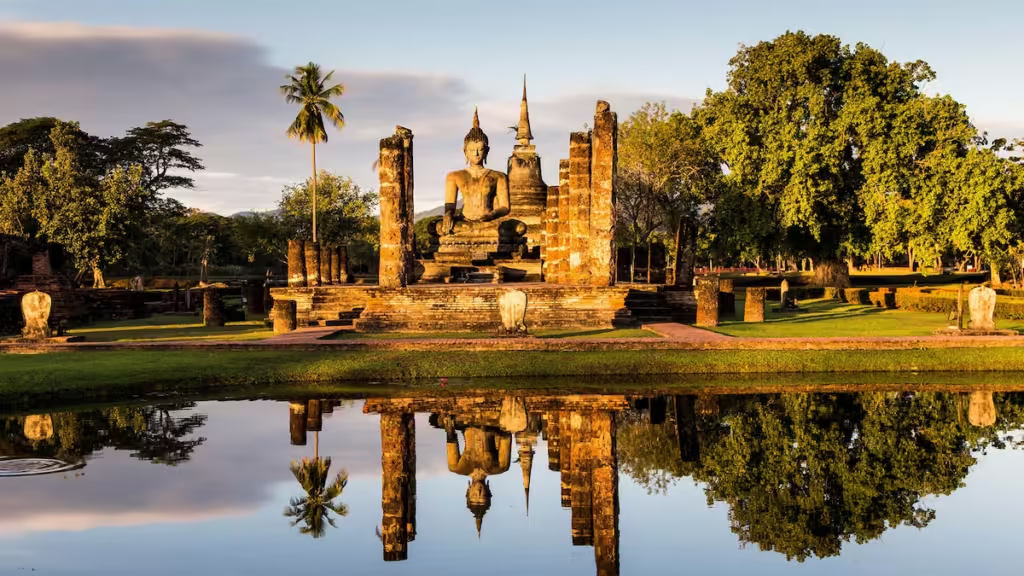
The Sukhothai Historical Park, located in northern Thailand, stands as a testament to the golden age of the Sukhothai Kingdom, which flourished from the 13th to the 14th centuries. This UNESCO World Heritage site is renowned for its well-preserved ruins, ancient temples, and impressive monuments that reflect the artistic and architectural brilliance of the era. The park’s centerpiece is the Wat Mahathat, with its iconic lotus-bud chedis and serene Buddha statues, showcasing the distinctive Sukhothai style of architecture characterized by graceful proportions and intricate details. Visitors can also explore the sprawling Wat Si Chum, home to the colossal seated Buddha known as Phra Achana, a masterpiece of Sukhothai artistry. The Sukhothai Historical Park offers a captivating journey back in time, allowing travelers to immerse themselves in the grandeur and cultural heritage of this once-thriving kingdom.
Overview of the Sukhothai Kingdom and its historical significance:
The Sukhothai Kingdom, founded in the 13th century by King Ramkhamhaeng, marked a pivotal period in Thai history and culture. Located in present-day northern Thailand, Sukhothai was known for its progressive governance, artistic achievements, and religious tolerance. The kingdom’s adoption of Theravada Buddhism as a state religion contributed to a flourishing of art, literature, and architecture, giving rise to the distinctive Sukhothai style characterized by elegant Buddha statues, lotus-bud chedis, and graceful stucco reliefs. Sukhothai’s emphasis on local governance and cultural patronage laid the foundations for later Thai dynasties, earning it a revered place in the nation’s history as a beacon of enlightenment and artistic innovation.
Exploration of the park’s well-preserved ruins, temples, and ancient monuments:
The Sukhothai Historical Park, designated as a UNESCO World Heritage site in 1991, offers a captivating journey through the remnants of the Sukhothai Kingdom’s capital. Spread across a vast area, the park is home to numerous well-preserved ruins, temples, and ancient monuments that showcase the kingdom’s architectural and artistic prowess. Highlights include the Wat Mahathat, featuring intricately carved Buddha images and lotus-bud chedis, and the Wat Si Chum with its colossal seated Buddha statue, Phra Achana. Visitors can also explore the Wat Sra Sri, known for its serene atmosphere and beautiful pond reflections, and the Ramkhamhaeng National Museum, which houses artifacts and exhibits detailing Sukhothai’s history and cultural legacy.
UNESCO World Heritage status and preservation efforts:
The Sukhothai Historical Park’s UNESCO World Heritage status underscores its global significance as a cultural and historical treasure. The designation has led to increased international recognition and support for preservation efforts aimed at safeguarding the park’s heritage for future generations. Conservation initiatives include restoration projects, archaeological research, and visitor education programs to promote sustainable tourism and appreciation of Sukhothai’s rich legacy. The park’s well-preserved ruins, temples, and ancient monuments serve as living testimonials to the Sukhothai Kingdom’s enduring contributions to Thai history, art, and culture, making it a must-visit destination for history enthusiasts and cultural explorers alike.
Chiang Mai Old City
The Chiang Mai Old City is a captivating enclave nestled within the bustling metropolis of northern Thailand. Encircled by ancient walls and moats that once served as protective fortifications, this historic district is a living testament to Chiang Mai’s rich cultural heritage and centuries-old legacy.
As the former capital of the Lanna Kingdom, Chiang Mai Old City exudes a palpable sense of history and tradition. Its narrow lanes and alleyways are lined with traditional wooden houses, intricately adorned temples, and bustling markets, offering a glimpse into a bygone era fused harmoniously with modern life.
At the heart of the old city lies the iconic Wat Phra Singh, a revered temple showcasing exquisite Lanna-style architecture, elaborate murals, and a revered Buddha image. Nearby, the imposing Wat Chedi Luang, with its towering pagoda and ancient stone elephants, stands as a testament to the city’s spiritual and architectural grandeur.
Exploring Chiang Mai Old City is a sensory delight, with aromatic street food stalls, vibrant night markets, and quaint coffee shops inviting visitors to savor the flavors and rhythms of local life. The Three Kings Monument, depicting Chiang Mai’s founding monarchs, and the historic Tha Pae Gate, once a gateway to the ancient city, further enrich the cultural tapestry of this enchanting district.
While modern developments have transformed Chiang Mai into a cosmopolitan hub, the Old City remains a cherished sanctuary where traditions thrive and history unfolds at every turn. Whether wandering through centuries-old temples, shopping for handcrafted souvenirs, or indulging in delectable Northern Thai cuisine, a journey through Chiang Mai Old City is a journey back in time, where the past seamlessly intertwines with the present, creating an unforgettable experience for travelers and history enthusiasts alike.
Introduction to Chiang Mai’s history and role as the capital of the Lanna Kingdom:
Chiang Mai, affectionately known as the “Rose of the North,” boasts a rich history dating back over 700 years. Founded in 1296 as the capital of the Lanna Kingdom, Chiang Mai played a pivotal role in the region’s political, cultural, and economic landscape. Its strategic location along ancient trade routes facilitated cultural exchanges with neighboring kingdoms, resulting in a vibrant blend of Lanna, Thai, Burmese, and Chinese influences that define the city’s unique identity.
As the heart of the Lanna Kingdom, Chiang Mai flourished as a center of art, religion, and learning, nurturing a rich heritage of craftsmanship, Buddhist scholarship, and traditional customs. The city’s iconic temples, ancient city walls, and cultural traditions continue to echo its illustrious past and enduring legacy as a cultural capital of Northern Thailand.
Tour of the old city walls and historical landmarks, such as Wat Phra That Doi Suthep and Wat Chedi Luang:
A tour of Chiang Mai’s old city walls offers a glimpse into the city’s storied past and architectural splendor. The meticulously preserved remnants of the ancient fortifications, including gates such as Tha Pae Gate and Suan Dok Gate, serve as tangible reminders of Chiang Mai’s historical significance and defensive strategies.
Within the old city, travelers can explore renowned historical landmarks such as Wat Phra That Doi Suthep, a sacred mountaintop temple offering panoramic views of Chiang Mai and housing a revered Buddha relic. The temple’s intricate architecture, golden chedi, and elaborate murals reflect the region’s spiritual devotion and artistic achievements.
Another notable stop is Wat Chedi Luang, known for its massive pagoda that once soared to greater heights before an earthquake, as well as the revered Phra Buddha Singh statue housed within its grounds. The temple complex provides insights into Lanna-style architecture, religious practices, and the city’s enduring reverence for Buddhist traditions.
Cultural insights gained from museums within the old city:
Chiang Mai’s old city is also home to a wealth of museums and cultural institutions that offer deeper insights into the region’s heritage and artistic legacy. The Chiang Mai City Arts & Cultural Center showcases exhibits on local history, traditional crafts, and contemporary art, providing a comprehensive overview of Chiang Mai’s cultural evolution.
Additionally, the Lanna Folklife Museum offers a glimpse into Lanna customs, rituals, and folk traditions through interactive displays, artifacts, and multimedia presentations. Visitors can immerse themselves in the rich tapestry of Lanna culture, from traditional music and dance to culinary traditions and agricultural practices.
These museums within the old city serve as invaluable repositories of Chiang Mai’s cultural heritage, fostering appreciation, understanding, and preservation of the region’s diverse traditions and artistic expressions.
Historical Museums
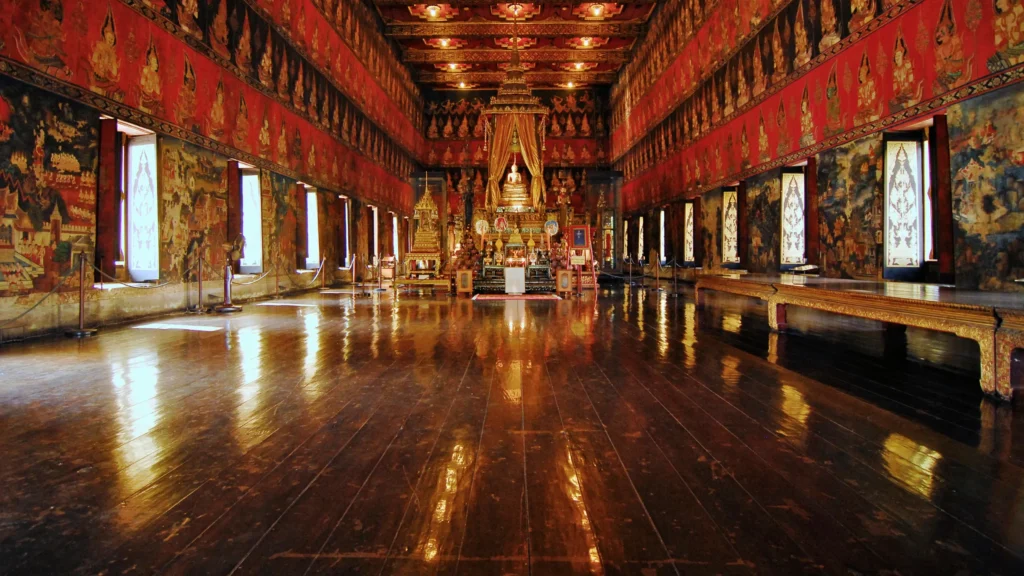
Historical museums in Thailand serve as invaluable repositories of the nation’s rich and diverse heritage, offering visitors immersive experiences that delve into various aspects of its history, culture, art, and traditions. These museums play a vital role in preserving, interpreting, and sharing Thailand’s past with both local and international audiences, fostering appreciation, understanding, and a sense of connection to the country’s heritage.
One of the most prominent historical museums in Thailand is the Bangkok National Museum, located in the capital city. This expansive museum houses a vast collection of artifacts, artworks, and historical exhibits spanning Thailand’s prehistoric era to the modern age. Visitors can explore ancient relics, royal regalia, religious artifacts, traditional costumes, and archaeological treasures, gaining insights into the country’s diverse cultural heritage and historical developments.
In Chiang Mai, the Chiang Mai City Arts & Cultural Center stands out as a hub of artistic and historical exploration. The museum showcases exhibits on Lanna history, traditional crafts, indigenous cultures, and contemporary art, providing a comprehensive overview of Northern Thailand’s cultural landscape. Visitors can learn about the region’s unique customs, festivals, music, dance, and craftsmanship through interactive displays, multimedia presentations, and educational programs.
Another notable museum is the Ayutthaya Historical Study Center, dedicated to the study and preservation of Ayutthaya’s rich history. The center features exhibits on the Ayutthaya Kingdom, its royal dynasties, architectural achievements, trade networks, and cultural exchanges. Through multimedia presentations, archaeological findings, and interpretive displays, visitors can unravel the complexities of Ayutthaya’s past and its enduring legacy in modern Thailand.
In addition to these major museums, Thailand boasts a wealth of smaller museums and cultural institutions scattered across the country. These include regional museums, art galleries, heritage houses, and thematic museums focusing on specific topics such as Thai silk, traditional medicine, maritime history, and ethnic diversity.
Overall, historical museums in Thailand serve as vital platforms for education, cultural exchange, and heritage conservation, fostering a deeper appreciation for the country’s past and its ongoing contributions to global civilization. Whether exploring ancient artifacts, royal collections, folk art, or contemporary interpretations of history, visitors to these museums embark on enriching journeys through time and culture.
Overview of major historical museums in Thailand:
Thailand is home to several major historical museums that showcase the country’s rich cultural heritage and historical evolution. The Bangkok National Museum stands as a cornerstone of historical preservation in the capital city, housing an extensive collection of artifacts, artworks, and exhibits that span Thailand’s diverse history from ancient civilizations to the modern era. The museum’s comprehensive displays include archaeological finds, religious artifacts, royal regalia, traditional costumes, folk art, and ethnographic collections, providing visitors with a deep dive into Thailand’s multifaceted heritage.
In Chiang Mai, the Chiang Mai City Arts & Cultural Center takes center stage as a cultural hub showcasing the region’s unique identity and historical legacy. The museum’s exhibits cover a wide range of topics, including Lanna history, traditional crafts, indigenous cultures, contemporary art, and local customs. Through interactive displays, multimedia presentations, and educational programs, the center offers visitors an immersive experience that illuminates Chiang Mai’s vibrant cultural landscape and artistic heritage.
Exhibits and artifacts showcasing Thailand’s history
Historical museums in Thailand curate a diverse range of exhibits and artifacts that chronicle the country’s history, offering a chronological journey from ancient times to the present day. Visitors can explore artifacts from prehistoric settlements, ancient civilizations such as Dvaravati and Srivijaya, Khmer influences, Sukhothai and Ayutthaya kingdoms, colonial encounters, and modern developments.
Exhibits may include archaeological discoveries, religious sculptures, ceremonial objects, royal paraphernalia, traditional crafts, historical documents, photographic archives, and multimedia presentations that bring history to life. Artifacts related to Buddhism, monarchy, trade, warfare, artistry, and daily life provide insights into Thailand’s cultural evolution, societal norms, technological advancements, and artistic achievements across different periods.
Importance of museums in preserving and sharing cultural heritage:
Museums play a crucial role in preserving and sharing Thailand’s cultural heritage by safeguarding artifacts, artworks, and historical records for future generations. These institutions employ conservation techniques, archival practices, and research methodologies to ensure the longevity and authenticity of cultural artifacts, thereby protecting tangible and intangible heritage from decay, loss, or destruction.
Moreover, museums serve as educational platforms that promote public engagement, scholarly inquiry, and cultural appreciation. They offer curated narratives, interpretive frameworks, and interactive experiences that facilitate learning, dialogue, and cross-cultural understanding. By showcasing diverse perspectives, historical contexts, and artistic expressions, museums contribute to fostering a sense of identity, pride, and connection to heritage among local communities and global visitors alike.
In essence, museums in Thailand serve as custodians of cultural memory, bridges between past and present, and catalysts for intercultural dialogue, making them invaluable contributors to the preservation, interpretation, and celebration of the country’s rich cultural heritage.
River Kwai and Death Railway
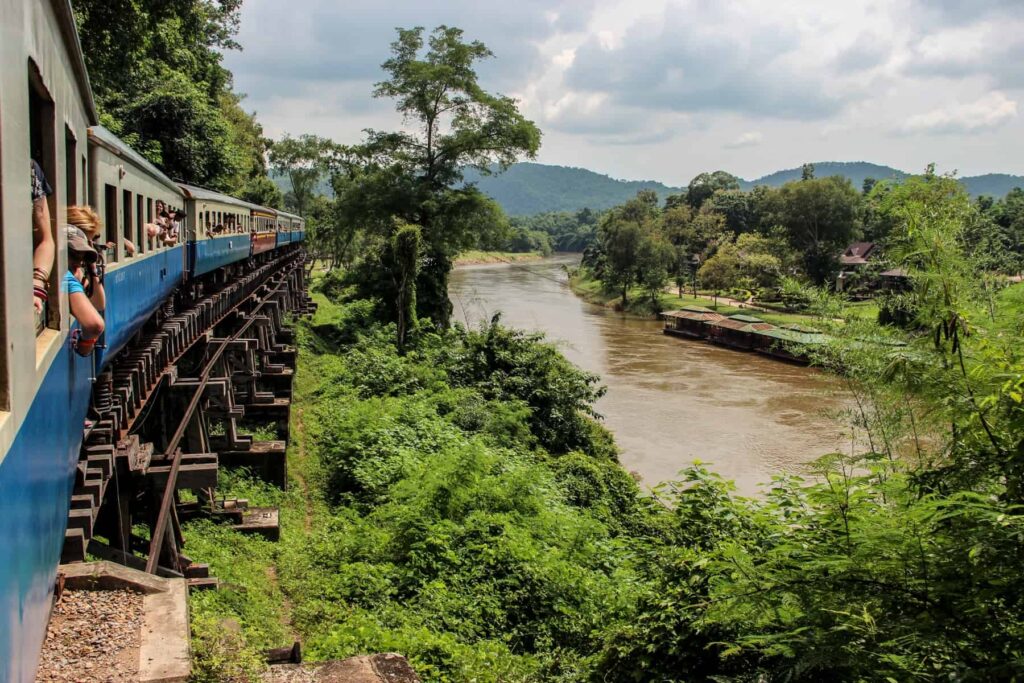
The River Kwai and Death Railway hold profound historical significance as poignant reminders of the human cost and resilience amidst the backdrop of World War II. The River Kwai, located in Kanchanaburi province, Thailand, gained global recognition due to its association with the construction of the Thailand-Burma Railway, famously known as the Death Railway.
During the Japanese occupation of Southeast Asia in World War II, prisoners of war and forced laborers, including Allied prisoners and Asian civilians, were subjected to harsh conditions and brutal treatment while constructing the railway under grueling circumstances. The railway, stretching from Thailand to Myanmar (then Burma), was intended to provide a strategic supply route for Japanese forces but came at a staggering human cost, with thousands of lives lost due to disease, malnutrition, and harsh working conditions.
Today, the River Kwai and Death Railway serve as important historical sites and memorials, commemorating the sacrifices and resilience of those who endured unimaginable hardships during the war. Visitors can embark on tours to explore these sites, including the famous Bridge over the River Kwai, immortalized in literature and film, which symbolizes the human spirit’s triumph over adversity.
A visit to the River Kwai and Death Railway offers profound insights into the realities of war, the resilience of the human spirit, and the importance of remembrance and reconciliation. Museums, memorials, and interpretive exhibits along the railway route provide historical context, personal stories, and educational resources, fostering a deeper understanding of this tragic chapter in history and honoring the memory of those who suffered and perished during its construction.
Historical context of the Bridge over the River Kwai
The Bridge over the River Kwai and the Death Railway are indelibly linked to the tumultuous events of World War II in Southeast Asia. Following the Japanese invasion and occupation of Thailand in 1942, prisoners of war (POWs) from Allied forces, along with Asian laborers, were conscripted to construct a strategic railway line between Thailand and Myanmar (then Burma). This railway, known as the Death Railway due to the staggering human toll it exacted, aimed to provide a supply route for Japanese forces in their campaign against British-held territories in Southeast Asia.
The construction of the Death Railway was marked by extreme hardships, including forced labor, inadequate supplies, brutal treatment, and deplorable living conditions. Thousands of POWs and laborers perished due to diseases like malaria, starvation, and exhaustion. The Bridge over the River Kwai, a critical part of the railway, gained notoriety due to its challenging construction and the human suffering associated with its completion.
Tour of Kanchanaburi province’s sites related to wartime history:
Kanchanaburi province in Thailand serves as a poignant memorial to the wartime history associated with the Bridge over the River Kwai and the Death Railway. Visitors can embark on tours that delve into the region’s wartime heritage, exploring sites such as the War Cemetery, where many Allied POWs are interred, and the JEATH War Museum, which documents the harrowing experiences of prisoners and laborers during the railway’s construction.
The Bridge over the River Kwai itself is a focal point of the tour, offering a somber yet reflective experience as visitors walk across the bridge and contemplate the sacrifices made during the war. The nearby Kanchanaburi War Museum provides further insights into the region’s wartime history, showcasing artifacts, photographs, and personal accounts that highlight the human impact of conflict.
Other notable sites in Kanchanaburi province related to wartime history include Hellfire Pass, a section of the railway where POWs endured grueling conditions during excavation, and the Hellfire Pass Memorial Museum, which pays tribute to those who suffered and perished during this dark chapter of history.
Reflection on the impact of war on Thailand’s history and society:
The legacy of World War II and the construction of the Death Railway has had a profound impact on Thailand’s history and society. The wartime experiences of POWs, laborers, and civilians left deep scars and reshaped the socio-economic landscape of the country. The enduring memory of the war serves as a reminder of the importance of peace, reconciliation, and international cooperation in preventing such tragedies from recurring.
The Bridge over the River Kwai and the Death Railway have also become symbols of remembrance and reconciliation, attracting visitors from around the world who come to pay their respects, learn about history, and reflect on the human cost of war. The preservation of these sites and the ongoing efforts to educate future generations about the war’s impact underscore Thailand’s commitment to honoring the memory of those who suffered and to promoting a world free from conflict and suffering.
Phimai Historical Park and Phra Pathom Chedi
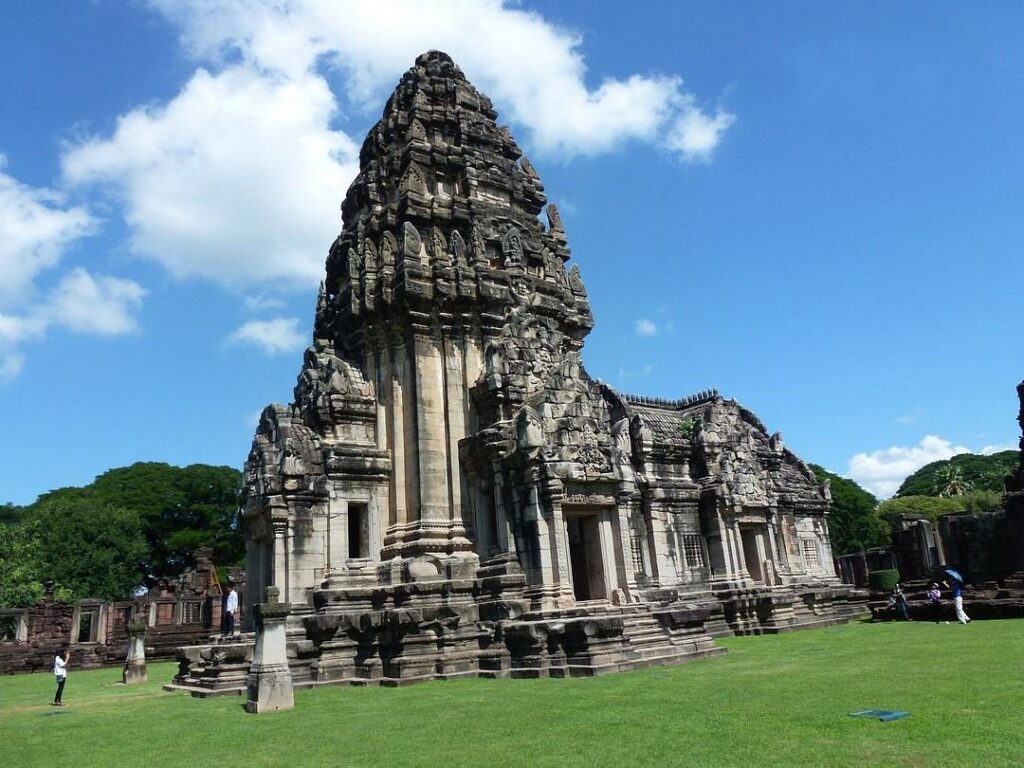
Phimai Historical Park, located in Nakhon Ratchasima Province, Thailand, is an archaeological gem showcasing the grandeur of the Khmer Empire’s architectural mastery. This park, designated as a UNESCO World Heritage site, is home to one of the most important Khmer temples outside of Cambodia, the Phimai Sanctuary.
The Phimai Sanctuary, dating back to the 11th century, is a magnificent example of classical Khmer architecture, characterized by intricately carved sandstone temples, towering prangs (towers), and elegant galleries. The temple complex, dedicated to Hindu deities like Shiva and Vishnu, features exquisite bas-reliefs depicting mythological scenes, celestial beings, and epic battles, providing a visual narrative of Khmer cosmology and cultural beliefs.
Visitors to Phimai Historical Park can explore the sprawling temple grounds, marvel at the artistic details of lintels and pediments, and admire the serene beauty of lotus-filled ponds and shaded walkways. The park’s serene ambiance and historical significance make it a popular destination for history enthusiasts, photographers, and cultural travelers seeking to immerse themselves in Thailand’s ancient past and Khmer heritage.
Phra Pathom Chedi:
Phra Pathom Chedi, located in Nakhon Pathom Province, holds the distinction of being the tallest stupa in the world and one of the oldest Buddhist structures in Thailand. This revered monument, dating back over two millennia, is a symbol of Thailand’s deep-rooted Buddhist heritage and spiritual devotion.
The stupa, standing at a height of over 120 meters, is an impressive architectural marvel adorned with intricate carvings, decorative motifs, and sacred relics. Its massive dome, surrounded by smaller stupas and ornate pavilions, exudes a sense of reverence and tranquility, drawing pilgrims and visitors alike to pay homage and seek spiritual blessings.
Phra Pathom Chedi is steeped in history and legend, believed to enshrine relics of Lord Buddha and serve as a sacred site of worship and pilgrimage for Buddhists. The surrounding temple complex, Wat Phra Pathom Chedi, features ornate halls, meditation gardens, and exquisite Buddhist art, offering a serene retreat for contemplation and reflection.
Visitors to Phra Pathom Chedi can ascend the stupa’s spiral staircase to enjoy panoramic views of Nakhon Pathom and the surrounding countryside, gaining a heightened sense of spiritual elevation and cultural appreciation. The stupa’s enduring presence and cultural significance make it a timeless symbol of Thailand’s Buddhist heritage and a testament to the country’s enduring devotion to the Dhamma (teachings of Buddha).
Description of Phimai Historical Park:
Phimai Historical Park, nestled in the heart of Nakhon Ratchasima Province in Thailand, stands as a magnificent testament to the architectural prowess of the Khmer Empire. This historical park, designated as a UNESCO World Heritage site, encompasses a sprawling Khmer temple complex known as the Phimai Sanctuary.
The Phimai Sanctuary, dating back to the 11th and 12th centuries, is a masterpiece of classical Khmer architecture. Its elegant sandstone structures, intricate carvings, and majestic prangs (towers) reflect the grandeur and artistic sophistication of the Khmer civilization. The temple complex, dedicated to Hindu deities like Shiva, Vishnu, and Brahma, served as a religious and ceremonial center, showcasing the Khmer Empire’s cultural and spiritual heritage.
Visitors to Phimai Historical Park can explore the meticulously preserved ruins of the Phimai Sanctuary, including the main sanctuary (prang), libraries, galleries, ponds, and surrounding walls. The site’s architectural layout, bas-reliefs depicting mythological scenes, and decorative motifs offer a glimpse into Khmer cosmology, religious beliefs, and artistic achievements.
Exploration of the ancient ruins and Khmer architecture at Phimai Sanctuary:
Exploring the ancient ruins and Khmer architecture at Phimai Sanctuary is a captivating journey into Thailand’s rich cultural heritage. The sanctuary’s main prang, adorned with intricate carvings of deities, celestial beings, and mythical creatures, stands as a majestic centerpiece amidst lush greenery and tranquil surroundings.
Visitors can wander through the galleries and courtyards of the Phimai Sanctuary, admiring the craftsmanship of sandstone lintels, pediments, and sculptures that depict scenes from Hindu epics like the Ramayana and Mahabharata. The site’s architectural layout, with its axial alignment and symbolic elements, reflects the Khmer Empire’s spiritual beliefs and ritual practices.
The Phimai Sanctuary’s serene ambiance, historical significance, and artistic beauty make it a favored destination for cultural enthusiasts, history buffs, and photographers seeking to uncover Thailand’s Khmer heritage and immerse themselves in the timeless charm of ancient ruins.
Visit to Phra Pathom Chedi in Nakhon Pathom:
Phra Pathom Chedi, located in Nakhon Pathom Province, Thailand, holds the distinction of being the world’s tallest stupa and is revered as one of the oldest Buddhist monuments in the country. This monumental stupa, standing at over 120 meters tall, is a symbol of Thailand’s deep-rooted Buddhist heritage and spiritual devotion.
The origins of Phra Pathom Chedi trace back over two millennia, with historical records indicating its construction during the reign of King Ashoka in the 3rd century BCE. Over the centuries, the stupa underwent various renovations and expansions, becoming a sacred pilgrimage site for Buddhists and a center of Buddhist learning and meditation.
Visitors to Phra Pathom Chedi can marvel at its imposing structure, adorned with intricate carvings, decorative motifs, and gilded spires. The stupa’s massive dome enshrines relics of Lord Buddha, making it a revered site of veneration and worship for Buddhists from Thailand and around the world.
The surrounding temple complex, Wat Phra Pathom Chedi, features ornate pavilions, meditation halls, and serene gardens, offering a tranquil sanctuary for spiritual contemplation and cultural exploration. The stupa’s historical significance, architectural grandeur, and spiritual resonance make it a must-visit destination for those seeking to connect with Thailand’s Buddhist heritage and experience the essence of spiritual tranquility.
Lopburi
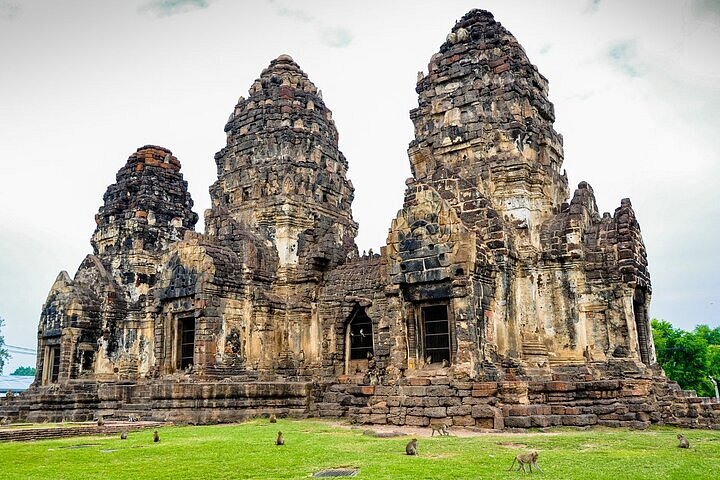
Lopburi, often referred to as the “Monkey City,” is a captivating destination located in central Thailand. This historic city holds a rich cultural heritage, blending ancient ruins, Khmer architecture, and vibrant local traditions.
The history of Lopburi dates back over a thousand years, with its origins intertwined with the Khmer Empire’s influence in the region. The city flourished as a significant center of trade, religion, and governance, leaving behind a legacy of magnificent temples, royal palaces, and fortifications.
One of the most iconic landmarks in Lopburi is the Phra Prang Sam Yot, a Khmer-style temple known for its three towering prangs and the playful monkeys that inhabit its grounds. These monkeys have become synonymous with Lopburi, adding a unique charm to the city’s allure.
Another must-visit site is the ancient ruins of Wat Phra Si Mahathat, featuring a stunning Buddha statue surrounded by intricate stucco reliefs and ornate architecture. The temple complex offers a glimpse into Lopburi’s spiritual heritage and artistic achievements.
Lopburi is also home to the Lopburi National Museum, which houses a diverse collection of artifacts, sculptures, and historical exhibits showcasing the city’s evolution from ancient times to the present day. Visitors can delve into Lopburi’s past through archaeological finds, religious artifacts, and cultural artifacts that illuminate the city’s role in Thai history and civilization.
Beyond its historical treasures, Lopburi captivates visitors with its lively markets, traditional cuisine, and colorful festivals. The city’s vibrant atmosphere, coupled with its rich historical tapestry, makes it a fascinating destination for travelers seeking to immerse themselves in Thailand’s cultural heritage and experience the dynamic essence of Lopburi.
Overview of Lopburi’s historical attractions and Khmer influence:
Lopburi, situated in central Thailand, is a city steeped in history and cultural heritage, with influences dating back to the Khmer Empire’s reign in the region. The city’s historical attractions offer a glimpse into its rich past, blending ancient ruins, Khmer architecture, and significant cultural sites.
One of Lopburi’s key historical attractions is the Phra Narai Ratchaniwet, also known as the King Narai’s Palace. This grand palace complex, built during the Ayutthaya period, showcases a blend of Thai, Khmer, and European architectural styles, reflecting Lopburi’s multicultural heritage and historical significance as a royal residence.
The city’s Khmer influence is evident in temples such as the Phra Prang Sam Yot, a Khmer-style temple with three imposing prangs that stand as a testament to Lopburi’s ties to the Khmer Empire. The intricate carvings, sandstone architecture, and symbolic motifs found in these temples highlight the artistic and religious exchanges between Lopburi and the Khmer civilization.
Tour of Phra Prang Sam Yot and other ancient temples:
A tour of Lopburi’s ancient temples is a journey through time, exploring the city’s religious and architectural heritage. The Phra Prang Sam Yot, with its three towering prangs and playful monkey residents, is a must-visit site that exemplifies Khmer-style architecture and Lopburi’s unique charm.
Other ancient temples worth exploring include the Wat Phra Si Mahathat, known for its impressive Buddha statue and intricate stucco reliefs depicting scenes from Buddhist mythology. The Wat Phra Sri Rattana Mahathat is another notable temple, featuring a magnificent chedi and well-preserved murals that showcase Lopburi’s artistic achievements.
Visitors can also discover hidden gems like the Wat Yang Na Rangsi, a serene temple complex with ancient ruins and a peaceful ambiance perfect for contemplation and photography. Exploring these ancient temples offers insights into Lopburi’s spiritual heritage, architectural prowess, and cultural significance.
Interaction with Lopburi’s famous monkey population and their historical context:
Lopburi’s famous monkey population adds a unique dimension to the city’s allure, with macaques roaming freely around temples, streets, and public spaces. These monkeys, often referred to as the “Monkey City” residents, have become iconic symbols of Lopburi and are intertwined with the city’s historical and cultural context.
According to local lore, the monkeys of Lopburi are believed to be descendants of Hanuman, the mythical monkey king from the Hindu epic Ramayana. Their presence in Lopburi dates back centuries, with the monkeys being revered as sacred animals and guardians of temples.
Interacting with Lopburi’s monkey population offers visitors a memorable and entertaining experience, as they observe the playful antics and social dynamics of these intelligent creatures. However, it’s important to exercise caution and respect while interacting with the monkeys, following guidelines to ensure both human and monkey safety.
Understanding the historical context of Lopburi’s monkeys adds depth to the experience, highlighting the city’s cultural traditions, folklore, and harmonious coexistence with nature. Visitors can witness firsthand the unique bond between Lopburi’s residents and their mischievous monkey neighbors, creating lasting memories and fostering appreciation for the city’s rich cultural tapestry.
Conclusion
Exploring Thailand’s historical tours unveils a tapestry woven with tales of ancient civilizations, cultural exchanges, and architectural marvels. From the majestic ruins of Ayutthaya and Sukhothai to the Khmer-inspired temples of Lopburi and Phimai, each destination whispers secrets of bygone eras and the enduring spirit of Thai heritage. Through these historical tours, visitors traverse centuries, witnessing the evolution of art, religion, and society. The UNESCO World Heritage sites like Ayutthaya Historical Park and Sukhothai Historical Park stand as guardians of history, preserving the legacies of mighty kingdoms and artistic brilliance. Venturing into the heart of Thailand’s ancient capitals, travelers encounter the echoes of royal grandeur, intricate stonework, and sacred sanctuaries dedicated to gods and kings. The Bridge over the River Kwai and Death Railway speak of wartime resilience and human endurance, while Phra Pathom Chedi rises majestically, a beacon of Buddhist devotion and architectural splendor. In Lopburi, the playful monkeys and Khmer-inspired temples beckon, weaving tales of cultural exchange and historical significance. Through interactions with these iconic residents and explorations of ancient ruins, visitors connect with the vibrant past that shapes Thailand’s present. Historical tours in Thailand are not mere journeys through time; they are invitations to unravel the threads of heritage, to immerse in the narratives of triumphs and tribulations, and to appreciate the rich tapestry of a nation woven with resilience, creativity, and enduring spirit.
Recap of the diverse historical tours and sites in Thailand:
Thailand’s historical tours offer a kaleidoscope of experiences, ranging from ancient ruins to royal palaces, Khmer temples to wartime memorials. The journey begins with the majestic ruins of Ayutthaya and Sukhothai, showcasing the grandeur of past kingdoms and intricate architectural details. The Bridge over the River Kwai and Death Railway tell tales of wartime resilience and human spirit, while Phra Pathom Chedi stands as a testament to Buddhist devotion and architectural splendor. In Lopburi, the playful monkeys and Khmer-inspired temples add a unique charm, blending history with cultural immersion. Each site paints a vivid picture of Thailand’s diverse heritage, inviting travelers to delve into the layers of its past.
Importance of historical tourism in promoting cultural understanding and appreciation:
Historical tourism plays a pivotal role in fostering cultural understanding and appreciation. By exploring Thailand’s historical sites, travelers gain insights into the country’s rich tapestry of traditions, beliefs, and artistic expressions. These experiences promote cross-cultural dialogue, empathy, and respect for diverse heritage, bridging gaps and building connections between people of different backgrounds. Historical tourism also contributes to heritage conservation efforts, raising awareness about the importance of preserving cultural treasures for future generations to cherish and learn from.
Encouragement for travelers to explore Thailand’s rich history through guided tours and independent exploration:
For travelers seeking to uncover Thailand’s rich history, guided tours and independent exploration offer immersive and enriching experiences. Guided tours provide expert insights, context, and behind-the-scenes access to historical sites, enhancing the overall understanding and appreciation of Thailand’s heritage. On the other hand, independent exploration allows for personalized discoveries, spontaneous interactions, and a deeper connection with the local culture.
Whether joining a guided tour or venturing independently, travelers are encouraged to immerse themselves in Thailand’s historical tours, to walk in the footsteps of ancient civilizations, to marvel at architectural wonders, and to engage with the stories that shaped the nation. Each step taken is a journey through time, a chance to unravel the mysteries of the past, and a celebration of Thailand’s enduring legacy.
Read more Historical Tours in Vietnam


